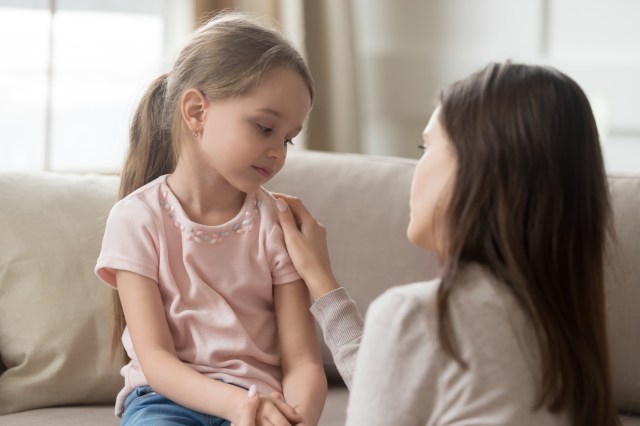One moment your kid is laughing and having fun, and the next she’s overcome with fear (maybe when leaving the house or faced with an unknown situation). Anxiety, especially separation anxiety, is a normal childhood stage, but some kids need a little more help to manage their fears. Luckily there are plenty of techniques to help a kid manage these feelings. We asked around and got experts to weigh in on what (and what not!) to do. Keep reading to find out more.
1. Don't reassure your kid that everything is fine. While you may know that's the reality of the situation, your anxious little one won't be able to understand the verbal platitudes. Resist the urge to reassure and instead show empathy. Tell your kiddo that you understand how she feels, and show her that you'll listen to her fears.
2. Get your child to relax before you talk. According to this NPR article, upset kids won't even be able to listen to your words until they're calm. Consider implementing yoga practices like deep breathing. These five yoga habits were developed by a kids' yoga instructor to promote calm and change the mood.
3. Help your child learn how to manage anxiety. Anxious kids tend to get stuck on the overwhelming feeling of fear. Instead of trying to eliminate the problem, Dr. Clark Goldstein, a child and adolescent psychologist, suggests helping your child learn how to manage it. He says "the best way to help kids overcome anxiety isn’t to try to remove stressors that trigger it. It’s to help them learn to tolerate their anxiety and function as well as they can, even when they’re anxious. And as a byproduct of that, the anxiety will decrease or fall away over time."
4. Shift the focus from What If to What Is. According to Renee Jain, the founder and chief storyteller of GoZen!, an online social and emotional learning platform for kids, shifting the mental focus from the future to the present can help to alleviate anxiety. Jain says, "Research shows that coming back to the present can help alleviate this tendency. One effective method of doing this is to practice mindfulness exercises. Mindfulness brings a child from what if to what is."
5. Enlist furry friends. Family pets and toys can go a long way to help your little one feel comforted and calm. Whether you have a family dog or cat, or your child has a favorite stuffed animal, encourage them to spend some time with their furry friends when they feel anxious.
6. Have goodbye rituals. Kids are creatures of habits, and while they may complain about keeping to a schedule, consistency goes a long way to help kids know what to expect and keep them calm. Having a goodbye ritual is extremely helpful if your kid suffers from separation anxiety. Keep to a regular routine of walking each other to the door, giving a kiss on the cheek and maybe saying a familiar phrase. This helps kids realize that just as the routine stays the same, so will mom or dad's return to them.
7. Help your child pay attention to his or her body. Mindfulness guru Mallika Chopra has written two books on coping strategies for kids ages 8-12 (Just Breathe, Just Feel). She says, "When you are feeling anxious, you often feel it in your body. Perhaps butterflies in your stomach or stiffness in your neck, perhaps pain in your feet or buzzing in your head. For kids and parents, connecting with feelings in their body can help them feel more in control and release tension. Take another deep breath in, putting attention where you are feeling unease, and imagine releasing it as you breathe out."
8. Develop a consistent bedtime routine. There's something about the dark that brings out fear in lots of kids. One way to calm an anxious child at night is to create a bedtime routine and stick to it. This may include reading a story together, brushing teeth, curling up with a favorite stuffed friend and going to bed at the same time each night. The routine and knowing what to expect goes a long way to help calm an anxious child.
9. Channel the anxiety into physical activities. These activities are a great way of redirecting the feelings of stress into a physical outlet. Daily walks or bike rides around the neighborhood are good ideas. If your kid needs a little more of a release, try a team sport like soccer or join a YMCA and enroll in gymnastics or martial arts class.
10. Encourage kids to express their fear through drawing or writing in a journal. Sometimes getting our fears out of our heads and onto the paper is a helpful way to help kids face fears. Just the act of releasing the fear can help an anxious child feel calm.
11. Recognize their positive strides. Struggling with an anxiety disorder is extremely tough for kids. So when your little one does something that helps them overcome their fears—even the smallest of things—recognize their effort.
